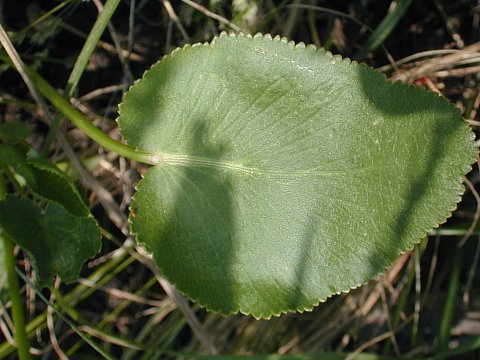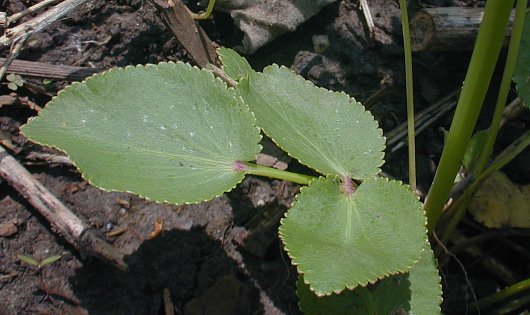Description: This herbaceous perennial plant is 1-2½' tall, branching sparingly in the upper half of the plant. The stems are hairless and round, with light green lines that run vertically. The basal leaves are undivided, up to 4" long and 3" across, and have petioles about 2-3" long. They are usually cordate or broadly ovate in overall shape, but with blunt or rounded tips. Otherwise, the leaves alternate up the stem, having progressively shorter petioles and a smaller size. The upper leaves are often ternately compound, and sometimes each leaflet is divided into three lobes. The surface of these leaves are often shiny, while their margins are serrate or crenate. There may be a purplish spot where the petiole meets the base of a leaf.

The upper stems
produce compound umbels of tiny yellow flowers. A typical umbel spans
about 2-3" across, and consists of about 7-15 umbellets, which in turn
have about 10-20 flowers. These flowers have short pedicels, except the
central flower of each umbellet, which is sessile. Each flower has 5
yellow petals that barely open, and is less than 1/8" across. The
blooming period occurs during late spring and lasts about a month.
There is no noticeable floral scent. Each flower is replaced by a small
fruit with 5 angular ribs – however, this fruit is not winged. The root
system consists of a central taproot.
Cultivation:
This plant prefers light shade to full sun, and mesic to dry
conditions. The soil can contain loam, clay-loam, or some rocky
material. This plant is easy to grow, and not much troubled by foliar
disease.

Range &
Habitat:
The native Heartleaf Golden Alexanders is restricted to NE Illinois,
where it is
an uncommon plant (see Distribution
Map). It also occurs in Hardin county of SE Illinois.
Habitats include moist to dry black soil prairies, hill prairies, rocky
upland woodlands, limestone glades, bluffs, abandoned fields, and
roadsides. Usually, this species occurs in drier locations than Zizia
aurea (Golden Alexanders).
Faunal Associations:
Various kinds of insects visit the flowers primarily for nectar,
especially small bees (Halictid, Andrenid, Nomadine) and flies
(Chloropid, Tachinid, Muscid, Syrphid, etc.), as well as occasional
beetles and plant bugs. The bees collect pollen as well, while some
flies and beetles may feed on pollen. The caterpillars of Papilio
polyxenes asterias (Black Swallowtail butterfly) feed on the
foliage of this and other members of the Carrot family.

Photographic
Location:
The photographs were taken at the wildflower garden of the webmaster in
Urbana, Illinois.
Comments:
Heartleaf Golden Alexanders differs from its close relative, Zizia
aurea (Golden Alexanders), by its simple basal leaves, while
the latter species has lower leaves that are compound. It also closely
resembles Thaspium trifoliatum var. aureum (Meadow
Parsnip), but differs from this species in two ways: 1) The central
flower of each umbellet is sessile, and 2) the angular fruits enclosing
the seeds lack wings. The central flower of each umbellet for the
Meadow Parsnip, on the other hand, has a short pedicel like the other
flowers, and its angular fruits are strongly winged and somewhat
flattened. These latter characteristics provide the Meadow Parsnip with
a slight advantage in the distribution of its seeds by wind.